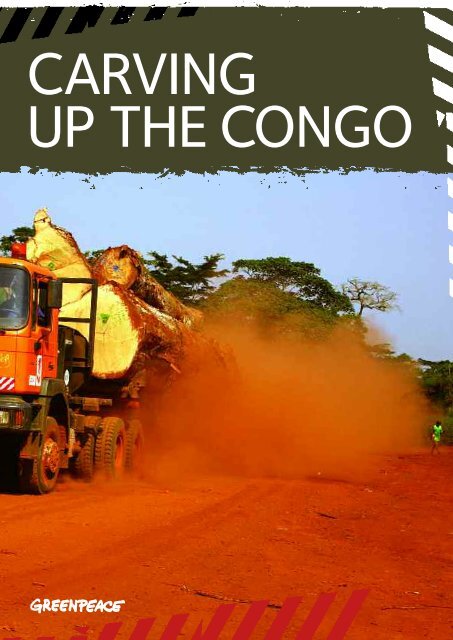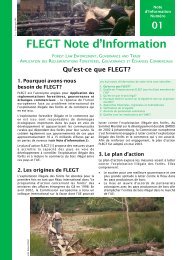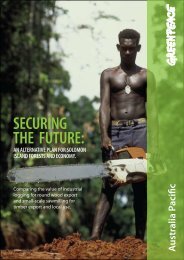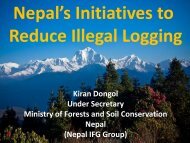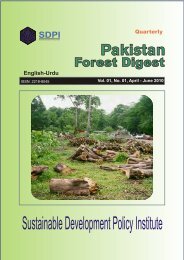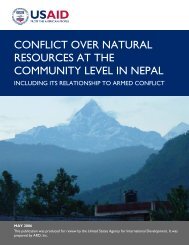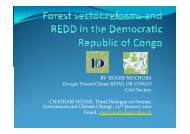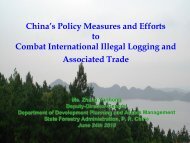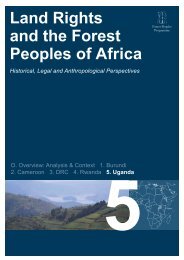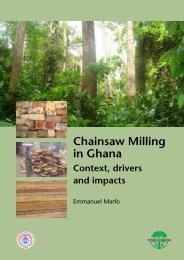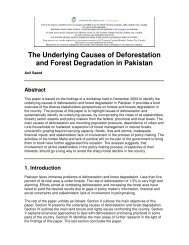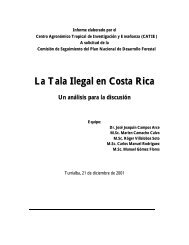Untitled - Illegal Logging Portal
Untitled - Illegal Logging Portal
Untitled - Illegal Logging Portal
You also want an ePaper? Increase the reach of your titles
YUMPU automatically turns print PDFs into web optimized ePapers that Google loves.
EXECUTIVE SUMMARY
CARVING UP THE CONGO 1WHAT A CARVE UP– KEY FACTS ABOUT DRCRAINFOREST DESTRUCTIONAND KEY QUESTIONS FORTHE WORLD BANKPUTTING IT ALL IN PERSPECTIVEClimate change caused by atmospheric buildupof greenhouse gases is the greatest threatthe world faces today. Global emissions fromtropical deforestation alone contribute up to25% of total annual human-induced CO 2emissions to the atmosphere.‘Industrial timber productionhas a particularly poor trackrecord in Africa. Over the pastsixty years, there is littleevidence that it has liftedrural populations out ofpoverty or contributed inother meaningful andsustainable ways to local andnational development.’ 1World Bank-led forestrysector analysis, 2007Predictions for future deforestation in CentralAfrica estimate that by 2050 forest clearancein the Democratic Republic of the Congo(DRC) will release a total of up to 34.4 billiontonnes of CO 2 , roughly equivalent to the UK’sCO 2 emissions over the last sixty years. TheDRC risks losing more than 40% of its forests,with transport infrastructure such as loggingroads being one of the major drivers.<strong>Logging</strong> roads open up the rainforest allowingaccess. With access comes commercialpoaching: the rainforests are being emptied oflarge mammals to feed the trade in commercialbushmeat and ivory. And once the rainforest isopened up by logging roads, the area becomesvulnerable to clearance for agriculture. Withroad clearance come CO 2 emissions fromrainforest destruction. With CO 2 emissionscomes further climate instability.<strong>Logging</strong> titles across Central Africa alreadycover some 50 million hectares of rainforest,an area the size of Spain. <strong>Logging</strong> companiesare effectively road engineers, laying down askeletal grid of arterial routes through intactrainforests. The swathes cleared through theforest for these logging roads can be widerthan some of Europe’s major motorways.Extensive logging roads and other logginginfrastructure are a significant source ofemissions through fragmenting anddegrading rainforests. As global emissionsfigures only take account of deforestation,the emissions resulting from suchfragmentation are currently overlooked.
2CARVING UP THE CONGO©Greenpeace/Davison‘Urgent intervention againstall forms of illegal naturalresource exploitation isrequired … The Group ofExperts recommends thatthe existing laws of theDemocratic Republic of theCongo, particularly theregulations governing naturalresources and their orderlyexploitation, be used as abaseline for a new sanctionsregime.’ 2United Nations SecurityCouncil Group of Experts,2007More than 20 million hectares of logging titlesare in the DRC, where due to war, therainforests has largely escaped destructionuntil now. This rainforest is now at risk of beingcarved up into logging concessions forcompanies to gain access to a handful ofvaluable timber species.The recent return of peace in the DRC and thenew Government provide a unique opportunityfor the international community to supportgenuine development in one of the world’spoorest countries and to take critical action toprotect the global climate.The World Bank’s support for developmentthrough extractive industries, including logging,is set to compromise the future of the DRC’srainforests, its people, and the global climate.WHAT’S AT STAKE?The Congo rainforests of Central Africa are ofglobal importance. They form the secondlargest rainforest block on earth after theAmazon rainforest, covering more than 172million hectares. The Congo rainforests arecritical to the survival of our closest animalrelatives: the bonobo, the chimpanzee and thegorilla. Yet only 8.5% of the remaining areas ofintact rainforests in Central Africa enjoy‘protected’ status.Rainforests represent important carbonreserves, and their preservation is critical tomaintaining the balance of the global climate.Two-thirds of the Congo’s remaining intactrainforests lie within the DRC. The DRC aloneaccounts for 8% of that part of the earth’scarbon which is stored in living forests. This ismore than any other country in Africa, and isthe fourth highest national store of forestcarbon in the world. More than a quarter of thecountry is still covered with large areas of intactrainforest, covering some 60 million hectares.The Congo Basin also has a significantinfluence over the regional climate.Representing the third largest region of deepconvection on earth after the Western Pacificand Amazonia, the Congo Basin affects rainfallpatterns over the North Atlantic.The DRC’s rainforests are critical for itsinhabitants. Of the more than 60 millionpeople in the DRC, about 40 million dependupon the rainforests to provide essential food,medicine, and other non-timber products,along with energy and building materials.WHAT IMPACT HAS THEWORLD BANK HAD IN THE DRC?The World Bank suspended financial assistanceto the DRC in the 1990s, as war broke outover control of natural resources. ‘Corruptand criminal elites’, backed by foreignmultinationals, joined in a free-for-all to gaincontrol of natural resources. While timberproduction was at a virtual standstill becauseof the war, about 43.5 million hectares offorest – an area larger than California andtwice the size of the United Kingdom – cameunder the control of the logging industry.The World Bank resumed lending to the DRCin 2001. It is now by far the largest funder ofreconstruction in the country. This puts it inunique position to influence the country’sdevelopment, for good or bad. By August2006, the World Bank Group had approvedloans, credits and grants to the DRC worthmore than $4 billion.HAS IT BROUGHT THE LOGGINGINDUSTRY UNDER CONTROL ANDSLOWED ITS EXPANSION?In May 2002, the World Bank convinced thetransitional DRC government to suspend theallocation of new logging titles and the renewalor extension of existing ones. This moratoriumfollowed a World Bank-instigated tax review oflogging contracts: 163 non-compliantcontracts covering 25.5 million hectares ofrainforest were cancelled. Most were ‘dormant’– that is, in areas not being logged.In its online Questions & Answers the WorldBank celebrates the ‘cancellation of non-compliantconcessions [sic]’ as ‘an unprecedented moveanywhere in the world’, critical to ‘slow[ing]the expansion of logging’ and ‘free[ing] upspace for potential new protected areas in therainforest part of the country.’While few new forest areas have beenprotected since the 2002 moratorium, byApril 2006 members of the transitional DRCgovernment had signed 107 new contractswith logging companies covering more than15 million hectares of forest. These includecontracts approved under the guise of
CARVING UP THE CONGO 3©Greenpeace/Davisonremapping, exchange, adjustments andrelocations of old titles, as well as out-andoutnew allocations.In a context of corruption and poor governancein the DRC, the World Bank’s attempts toreform the forestry sector are currently failingto control the expansion of logging.The World Bank’s latest attempt to control theexpansion of the logging industry is a so-calledlegal review of titles. 156 logging contractscovering 21 million hectares of rainforest arecurrently being assessed against compliancewith some basic legal criteria.Greenpeace has investigated the actionsof most of the major logging companieswhose contracts have been submitted to thelegal review. Our findings expose seriouslapses of governance, a massive lack ofinstitutional capacity to control the forestrysector, widespread illegalities and socialconflicts, as well as clashes with establishedconservation initiatives. As this reportreveals, foreign companies including Danzergroup (Siforco), ITB, the NST group (CFT,Forabola, Sodefor, Soforma), Olam, Sicoboisand Trans-M have all had new contractssigned after the May 2002 moratorium. Themajority have therefore benefited from theWorld Bank’s failure to ensure that themoratorium it negotiated with the transitionalDRC government and other forestry sectorreforms have been enforced.Greenpeace fears that the legal review couldbecome an exercise in laundering illegalcontracts. Do the World Bank and the DRCGovernment have the political will to crackdown on those who have benefited fromsuch corruption?A review of the 156 contracts underreview – Greenpeace’s key findings:107 out of 156 contracts were signed afterthe May 2002 moratorium. Only 40 of thosesigned prior to the moratorium appear to havepaid their area tax in 2004 (tax payment beinga criterion of the legal review, 2004 is the onlyyear for which government data, howeverinaccurate, is publicly available).Nearly half of the 156 titles are in intact forestlandscapes – critical for carbon storage andvery significant for wildlife protection.Because comprehensive maps are not publiclyavailable, the location of 13 contracts covering1.7 million hectares (an area the size ofKuwait) cannot be determined.All the contracts are in areas inhabited byforest-dependent communities; two-thirds
4CARVING UP THE CONGOoverlap areas inhabited by pygmyhunter-gatherers.A third of the contracts are inside areasalready identified as priority landscapes forconservation. Twenty of those contracts arelocated wholly or partially within the CongoBasin Forest Partnership’s Maringa-Lopori-Wamba landscape, critical bonobo habitat.A third of the contracts are located in areaswith afrormosia, a protected tree specieswhose international trade is supposed tobe strictly regulated (listed under CITESAppendix II).Challenges for the Legal ReviewIs the contract a straight violation of the2002 moratorium?Greenpeace research shows:s Companies, including Trans-M, seem tohave taken over areas previously occupiedby ‘non-compliant titles’ cancelled in April2002. Many of these contracts are locatedwithin intact forest landscapes.The implications of these findings areserious: such violations would mean that thecancellation of non-compliant titles in April2002 did little more than take logging rightsfrom speculative owners who did not use them,freeing up space for new logging operations.Do logging contracts comply with ‘boundariesas defined by the contract and thetopographical map attached to said contract’?As Greenpeace research shows:s Both NST group companies and the Danzergroup (Siforco) – which between them holdmore than 5 million hectares of rainforest– redefined many of their contracts andtitle boundaries after the moratorium wasdecreed in 2002 and in advance of thelegal review. Only through detailedcomparison of old and revised maps andboundaries can it be assessed whether therevised boundaries include new forest areasand therefore would be illegal under theMay 2002 moratorium. Yet, such pre- andpost-moratorium maps or contracts arenot publicly available.s ITB’s current forest holdings in EquateurProvince appear to be located in areasformerly held by cancelled non-compliantpre-2002 contracts and are larger thenthe forests controlled by ITB before themoratorium. Final conclusive analysis islacking because logging title maps bothpre- and post-moratorium are notpublicly available.Assessment of the legality of revisions to premoratoriumcontracts (for instance, where acompany has returned forest area to the State)should therefore include assessment of theoriginal contracts and maps as well as reviseddocuments to ensure there are no irregularities.Will the legal review overlook issues ofcorruption and failures of governance?Greenpeace research suggests that issues ofcorruption require close scrutiny for companiesincluding CFBC (a company said to have linkswith the former rebel leader Jean-PierreBemba), ITB, Trans-M, Danzer group (Siforco),NST group (Sodefor) and Olam. Issues include:s Payments to forestry officials;s Subcontracting (which is illegal, butcompanies may use loopholes in theForestry Code);s Historic payment of funds to rebel-heldadministrations;s Titles issued in wartime; ands Political protection afforded tocertain companies.Conclusion: the World Bank has so far failedin its objectives of controlling theexpansion of industrial logging andimproving governance of the sector. In theabsence of enforcement, the moratoriumhas been a cover for behind-the-scenesjostling for valuable forest holdings.‘We are seeing today anemerging global consensusthat we must do somethingabout climate change. If wedo so, we have a chance toput the world on a path thatnot only reduces the damageto our climate, but also allowpoor countries to keep moreof their resources rather thanpay for growing fuel bills– a path that allows themto preserve their forest fortheir own benefit and theworld’s benefit.’ 3Paul Wolfowitz,World Bank President
CARVING UP THE CONGO 5HAS IT RAISED MONEY FOR DEVELOPMENTAND PROVIDED PUBLIC SERVICES TO FORESTDWELLING COMMUNITIES?Central to the World Bank strategy in theDRC is the concept that by collecting taxbased on the surface area of loggingcompanies’ forest holdings, the Governmentwill obtain revenue to drive development,including improved provision of publicservices for rainforest communities.Where has the money gone?The World Bank-imposed Forestry Code of2002 stipulates that 40% of area tax is to beredistributed to local authorities fordevelopment projects. Not one dollar of thearea tax that has actually been collectedbetween 2003 and 2006 has beenredistributed to local authorities. Further, thereis gross tax avoidance: a DRC Ministry ofFinance list from 2005 reveals that 45% of thearea tax due from logging companies for theprevious year had not been paid; tax avoidancethrough timber smuggling is also a seriousissue – there are estimates that actual timberexport levels are as much as seven timeshigher than official figures.©Greenpeace/DanielsHas logging improvedthe life of local communities?Greenpeace research shows that all 156 titlesup for legal review are in areas inhabited byforest-dependent communities – and sometwo-thirds of these are known to be inhabitedby pygmy hunter-gatherer communities.The Forestry Code formalises a pre-existingprocess whereby a logging companynegotiates directly with communities as to theservices it will provide in exchange for loggingin their area.Greenpeace’s investigations show that inexchange for extracting wood worth manyhundreds of thousands of dollars, companiesmay give communities gifts worth as little as$100 in total. Once logging starts, theprovision of services negotiated for by thecommunity, such as school buildings, is ofteneither derisory or not delivered at all.For example:s Sodefor’s (an NST group company) giftpackage often comprises of two sacks ofsalt, 18 bars of soap, four packets ofcoffee, 24 bottles of beer and two bags ofsugar, in exchange for rainforest access. Asa result the communities effectively signaway their right to protest against thecompany’s activities.Greenpeace’s investigations show how loggingcan impact local community access to vitalforest resources.For example:s ITB has a built a log wharf in an importantfish breeding ground.s <strong>Logging</strong> companies frequently logcommunity caterpillar trees. Caterpillarsare a vital source of protein for forestdependent communities. ITB and Trans-Mare two cases.
6CARVING UP THE CONGOGreenpeace has also found that thenegotiation process itself often reinforcesthe marginalisation of pygmy huntergatherercommunities who are highlydependent on forest resources.s In ITB’s operations near Lake Tumba, aTwa pygmy community was initiallyexcluded from negotiations over access toforest. The company then made thecommunity a take-it-or-leave-it offer towhich the local chief felt he had no optionbut to agree.In addition, Greenpeace has identified anumber of examples of the DRC’s authoritiesusing violence to repress public dissent wherelogging companies have failed to fulfil theircommitments to local communities.s Protests by local people against CFBC,Safbois, Sodefor and many othercompany operations have been met withintimidation and arbitrary arrests by localauthorities. Conflicts between villagersand logging companies are almostuniversal, with local authorities oftentaking the side of the companies.Conclusion: the World Bank maintains theillusion that logging companies will belargely beneficial to local communitiesthrough their tax revenue and so-calledsocial responsibility contracts.HAS IT ACHIEVED RAINFORESTPROTECTION FOR PEOPLE, WILDLIFEAND THE GLOBAL ENVIRONMENT?Greenpeace research shows that of the 156titles up for legal review, nearly half are inintact forest landscapes – the very landscapesthat are most critical for carbon storage forthe sake of the global climate, and of greatsignificance for the DRC’s rich biodiversity.While in some cases beyond the remit of thelegal review, many operations are in areasthat have already been identified as priorityconservation landscapes. <strong>Logging</strong> is goingahead in these areas prior to any land useplanning to determine how best to conserveand manage these critical habitats.s Companies such as Trans-M and theDanzer group (Siforco) have contractsfor areas inside Maringa-Lopori-Wambalandscape, now a critical stronghold forsome of the last viable populations of wildbonobos in the DRC. Bonobo populationshave been decimated by the illegal tradein bushmeat, and from being hunted as asource of food during the recent wars.s Trans-M, whose contracts were signedafter the 2002 moratorium, and Safbois, acompany in conflict with localcommunities over its operations, arelogging in an uncontrolled manner largevolumes of afrormosia – a protected treespecies listed under Appendix II of CITES,meaning that its international trade issupposed to be regulated.Greenpeace’s research exposes just what athreat the selective logging practised acrossCentral Africa is to biodiversity and the globalenvironment. Selective logging requires anextensive road network. The impact oflogging infrastructure on the climate issignificant but does not figure in globalcalculations. Given that cross Central Africa,50 million hectares of rainforest arecontrolled by logging companies – an areathe size of Spain – the total impact is likely tobe significant. Forty million hectares arelocated in areas of intact forests.s Using satellite images, Google Earth andpublished scientific studies, Greenpeacehas calculated the predicted CO 2emissions from a 170,000 hectare areaof forest formerly logged by the Danzergroup (Siforco). Our calculations show thatlogging roads and other infrastructure(currently not part of international IPCCcalculations on ‘Land Use Change andForestry Emissions’) produce a level ofemissions 2.5 times greater than thatfrom the extraction of the commercialtimber itself (currently the only aspect ofindustrial logging operations included inestimates of the DRC’s emissions).Conclusion: There is still an opportunity toprotect large areas of intact rainforest, butaction must be taken swiftly. A moratoriumon any new logging title allocation needs tobe enforced until there is comprehensivenational land use planning that prioritisesthe needs of the DRC’s people and thelocal, regional and global environment.
CARVING UP THE CONGO 7©Greenpeace/ReynaersWHAT FUTURE FORTHE DRC’S RAINFORESTS?The legal review is a crunch point for theWorld Bank, the DRC Government and thecountry’s rainforests. The future of more than20 million hectares of forest hangs in thebalance. Will the World Bank ensure that thelegal review will not effectively launder illegaltitles and leave corruption unchallenged?Beyond the legal review, will the World Bankact in the interests of forest dwellingcommunities and the global environmentby adhering to the principles it promotes:poverty alleviation, good governance andenvironmental protection?The international donor community and theDRC Government must take steps to crackdown on corruption and stop the plunder:s Prevent the expansion of industrial loggingThey must also help start the solution:s Initiate land use planning andoverhaul of governances Develop viable policies and funding


